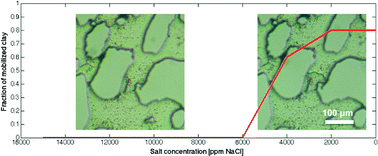Functionalization of micromodels with kaolinite for investigation of low salinity oil-recovery processes†
Abstract
Sandstone formations are ubiquitous in both aquifers and petroleum reservoirs, of which clay is a major constituent. The release of clay particles from pore surfaces as a result of reduced injection fluid salinity can greatly modify the recovery of hydrocarbons from subsurface formations by shifting the wettability properties of the rock. In this paper we demonstrate a microfluidic approach whereby kaolinite is deposited into a two-dimensional microfluidic network (micromodel) to enable direct pore-scale, real-time visualization of fluid–solid interactions with representative pore-geometry and realistic surface interactions between the reservoir fluids and the formation rock. Structural characterization of deposited kaolinite particles agrees well with natural modes of occurrence in Berea sandstones; hence, the clay deposition method developed in this work is validated. Specifically, more than 90% of the deposited clay particles formed pore-lining structures and the remainder formed pore bridging structures. Further, regions of highly concentrated clay deposition likely leading to so-called Dalmatian wetting properties were found throughout the micromodel. Two post-deposition treatments are described whereby clay is adhered to the silicon surface reversibly and irreversibly resulting in microfluidic systems that are amenable to studies on (i) the fundamental mechanisms governing the increased oil recovery during low salinity waterfloods and (ii) the effect of a mixed-wet surface on oil recovery, respectively. The reversibly functionalized platform is used to determine the conditions at which stably adhered clay particles detach. Specifically, injection brine salinity below 6000 ppm of NaCl induced kaolinite particle release from the silicon surface. Furthermore, when applied to an aged system with crude oil, the low salinity waterflood recovered an additional 14% of the original oil in place compared to waterflooding with the formation brine.


 Please wait while we load your content...
Please wait while we load your content...